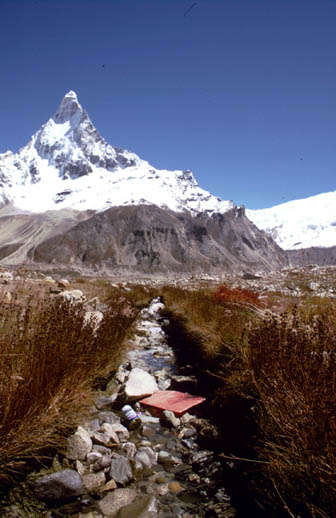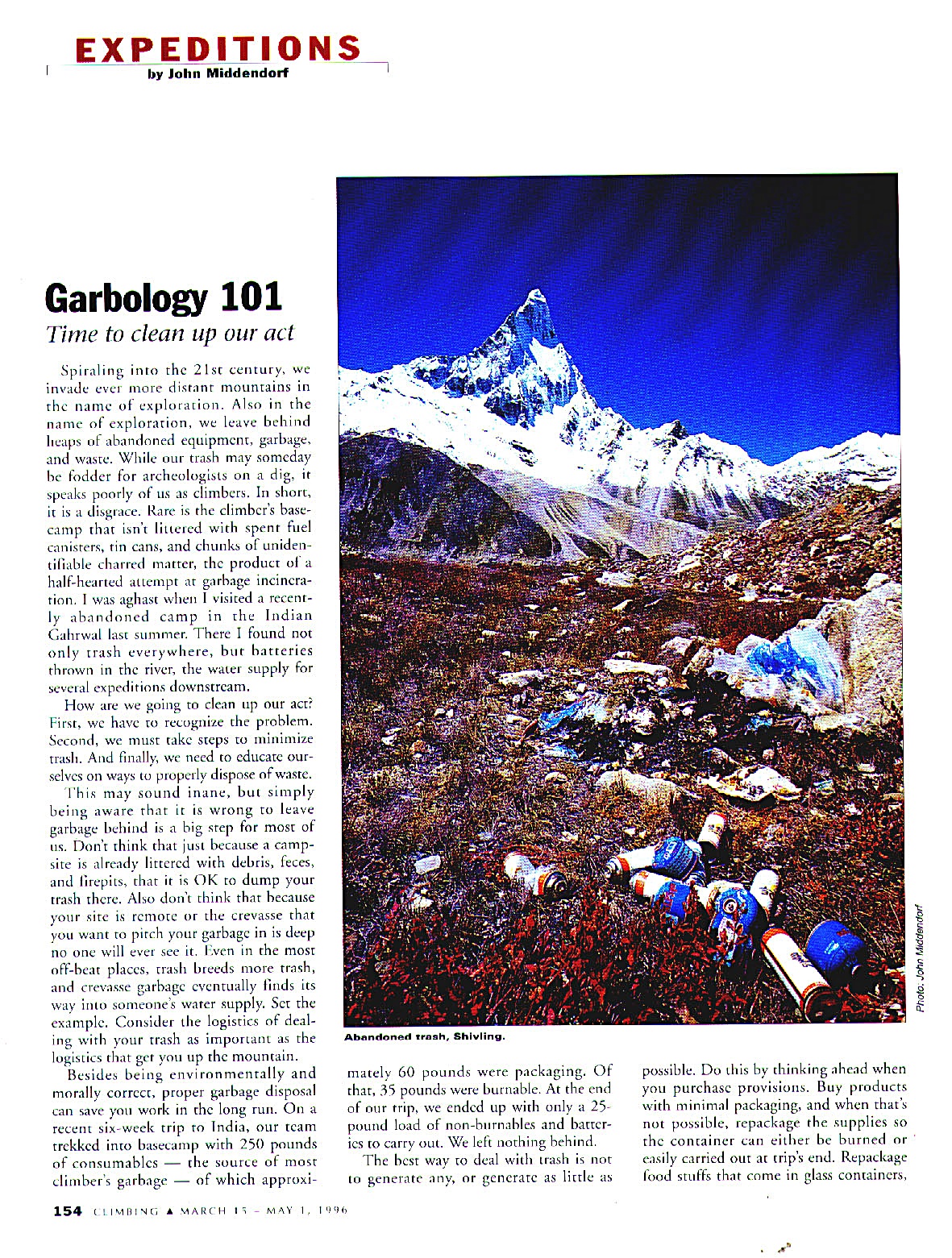
by John Middendorf
You have brains in your head,
you have feet in your shoes,
you can steer yourself any direction you choose.
--Dr. Seuss

Photo: Abandoned basecamp in India
As we progress into the 21st century, the presence of humankind extends into ever more distant boundaries. One of the characteristic impacts of the exploration of remote areas is piles of left-behind trash. It is nothing new: since the dawn of man and woman, items of no worth to the owner have been tossed by the wayside, much to archeologists and historians delight. But the artifacts of yesterday were of mostly organic origin and generally of no harm to the environment. Many indigenous cultures today, who are new to the concept of extensive packaging of consumable products, continue to throw useless items aside wherever they may be. The more recently the society is exposed to disposable packaging, the more the disposable items are strewn about. But the artifacts we leave behind today consists largely of inorganic items. Much of it is objectionable for aesthetic reasons, but much of it, like batteries and certain plastics, are objectionable for survival reasons.
One of the places where humans should be most careful is in the mountain ranges, which not only are the last remaining pristine places, but also where much of the world's drinking water comes from. Mountaineers, climbers, and trekkers turn out to be the worst offenders of mountain garbage, since these groups spend the most time in the remote mountains. As a community, we need to take a stand on this issue.
Garbage come in many forms, but the main categories are glass, metal, paper, plastic, and toxic items like batteries. Throughout the Himalaya and the mountain ranges of the world, one can find caches of such items left by international expeditions. One wonders whether or not these expeditions were leaving their version of a time capsule, or in some cases, trying to create something resembling a totem of possibly some arcane religion. In all cases, the garbage left by climbing expeditions in the mountains is a disgrace, especially when one learns how simple it is to have manageable garbage loads at the end of a trip.
Garbage can be further refined into specific categories: burnable items, semi-burnable, non-burnable, biodegradables, and toxic items. Semi-burnables are items like paper packaging with a foil liner, which can be burned and the remaining foil can be removed after the fire cools. Biodegradables include most food scraps and human waste, which can be disposed of in certain ways (human waste buried, and biodegradables scattered in a discreet area) as to have no lasting impact on the area.
As an example of how trash breaks down, on a recent six-week trip to India, we trekked into base camp with 250 pounds of consumables, of which I would estimate 60 pounds was packaging. Of that, 35 pounds was burnable. At the end of our trip, we ended up with only a 25 pound load of non-burnable items and batteries to carry out. We left nothing behind, and left our basecamps in better shape than when we arrived (we cleaned up some of the trash left by previous expeditions as well).
The first thing to plan for leaving a clean base camp in the mountains is during the purchasing of provisions for the trip. Buying products with minimal packaging is essential, and only a few glass items should be considered. High quality zip lock bags which can be used and reused many times are key in organizing food and reducing the stock packaging. These, incidentally, are not available in most third world countries, so bringing some from the homeland is required. Food should be repackaged in as little packaging as possible, which not only makes the clean up simpler, but also reduces the weight of the gear to carry into basecamp.
For cooking, consider using liquid fuel in all cases: piles of empty butane/propane canisters can also be found at every base camp in the world's mountain ranges. Compressed fuel canisters should only be considered for times when a gas stove is not practical. Kerosene stoves are common in Asia. Alternatively, bring a propane stove with a large refillable tank for base camp. Large propane tanks can be purchased and sold at the end of a trip in many area in South America. Be aware that the fittings must be converted to metric --metric fittings can be crimped to the stock pressure hose on a US Coleman stove with adapters and tools commonly available in hardware stores of many countries.
Glen Rink, Grand Canyon River Guide and master of garbology is under the firm belief that garbage maintenance can be fun. All it requires is the ability to wash your hands afterward and a little pyromania in the blood. The main key is keeping impact to a minimum in the mountains is really not how much tundra that is trampled, rather, it is the maintenance of the waste produced.
During a river trip down the Grand Canyon, I found it fascinating to watch the master himself at work. Glen, know to his friends as LB ("Little Buddy"), would take great care at the end of the day to unravel the soaked canvas garbage sack, sort out each and every piece of garbage according to type, allow the paper to dry, and proceed to reduce a giant mound of trash into a packet that you could fit in your pocket. He did this by building a small fire and burning each piece in a controlled manner. Simple, obvious, and effective. Why didn't we think of that? Instead, I must admit, I've been a unenlightened accomplice of the typical method of piling in one spot all the garbage from weeks of living in the mountains, pouring some gasoline over it, and tossing a match, hoping the mass of half burnable, half inert pile will combust properly. It generally won't, and will leave a disgusting blob of melted plastic, glass and metal coated by a charred black muck. Such artifacts can also be found in virtually every mountain ranges of the world. These are unappealing items to find stuck on a boulder in the middle of your chosen campsite.
The idea behind successful garbage reduction is to burn what will burn, and carry out everything that will not biodegrade immediately (like human waste and certain food scrapings). Things which must be carried out include glass, metal, and especially batteries. I was aghast (and found myself wondering about the fate of humankind) when I visited a recently abandoned camp in the Indian Gahrwal last summer when I not only found garbage everywhere but spent lead-acid and alkaline batteries thrown in the river which was the water supply for several expeditions downstream. As far as burying used batteries: now get real. If someone was playing in your backyard, would you appreciate them planting toxic batteries next to your garden? I've also seen charred batteries in a remnant base camp fires which makes me think how these folks were trying to accelerate the toxic feeding of the soil by burning off the shell. Lead doesn't burn. In fact, it is the only element that cannot be changed into anything but its liquid or gaseous form. It does, however, bond to other molecules to create toxic substances. The point here is that spent batteries must be carried out; anything else is inexcusable.
After sorting out the garbage, food scraps and biodegradables, glass and batteries, and burnable items should be separated into individual piles. Now the fun begins: the fire. The main key to successful garbage fire is: BIGGER IS NOT BETTER. Attempting to pile a huge mix of garbage usually results in a huge charred conglomerate with most of the bulk and weight intact. The small Navajo fire is superior to the so-called white-man fire, with burnable items added a little at a time. A fire about two foot square is about right. The other thing to keep in mind is frequent maintenance: a garbage burns at least every few days is necessary too keep the final job reasonable. Each garbage burn will require a few hours of time.
The big question here becomes, "What about plastic? Most plastic creates toxic fumes when burned." This may be true, and for that reason it becomes a personal choice whether to burn plastic or not. In the Himalaya, where all the garbage is likely to be eventually thrown into the river at the roadhead anyway, it seems like the best policy is to burn. But the main argument for burning plastic despite its atmospheric detriments, is to reduce the size of the garbage. On most trips, a big part of the bulk is plastic. Besides being a more manageable and easier load to carry, reduced garbage without plastic is more likely to be disposed of properly once a town is reached. Of course, stay upwind of fires burning plastic.
After each burn, sort out the tin-foil and the items that didn't burn properly leaving nothing but ashes. It takes some skill in making sure that all the plastic burned properly; otherwise, melted blobs of plastic will remain. Everything except for the ashes should be sorted out and put aside for transport out of basecamp.
The generally accepted practice today is to burn a massive pile of garbage all at once, with hopes that it will reduce significantly, and the remnant mess buried or thrown into a crevasse. Both burying trash and throwing trash in the crevasses are unacceptable and unnecessary practices. Conglomerates of buried trash are frequently dug up by birds and mountain animals, who will then strew the garbage around looking for the food scraps. Throwing garbage into a glacier is equally disgusting. Keep the mountains pure. Every bit adds up to the contamination of the wilds. The point is to keep it out of the mountains. The techniques outlined above will keep the mountains pristine for many generations to come.
As the Indian LO Harish C. Thakus said, as we sadly looked upon a trashed abandoned base camp in Topoban, "These are not the signs of a good mountaineer".
